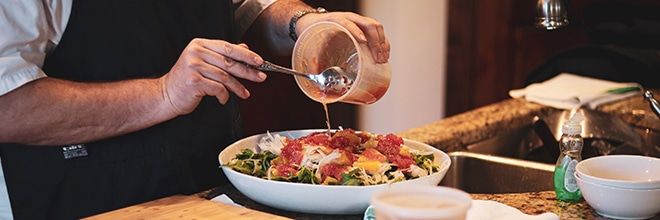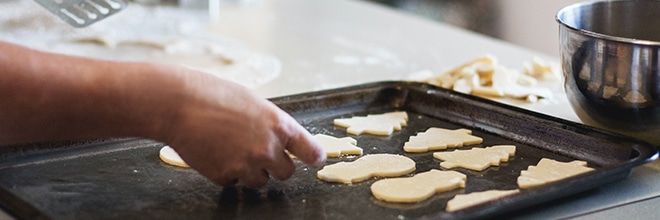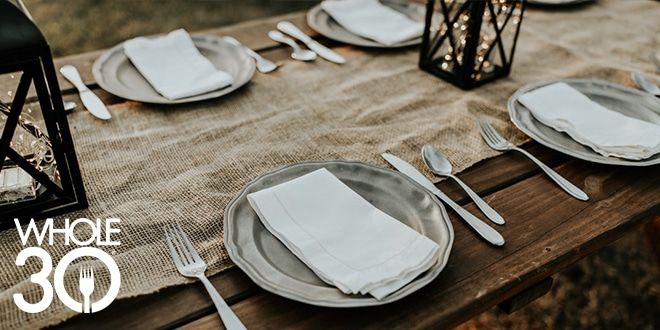
The holiday season is approaching, and although this year will look different in many households, many of your concerns remain the same. You want to know how to navigate your Whole30 at holiday events, what recipes you can make that are compatible; to talk about Whole30 to family members that don’t get it; and how to find the sweet spot of navigating your food freedom with holiday traditions and endless treats.
Just like we believe there is no one-size-fits-all diet, we also believe there’s no one right way to approach these decisions. We’ve asked 5 people to share their advice on your commonly asked questions about navigating holiday eating and events. These different perspectives will help you discover strategies that align with your beliefs to confidently think through how you want to navigate this season.
Here’s a little background about our contributors:

Melissa Urban
Co-founder and CEO of the Whole30 program and a six-time New York Times bestselling author.

Maya Feller, RD
A speaker, writer, and national nutrition expert, Maya is a registered dietitian nutritionist focused on approachable, real food based solutions.

Abeer Najjar
A self-taught chef & food writer, Abeer writes to preserve memories of cooking with her mother & to share her food experience as a child of immigrants.

Steph Greunke, RD
Registered Dietitian and Education Manager for Whole30, certified in perinatal mental health and host of the Doctor Mom podcast. Steph makes healthy eating accessible through the science of behavior change.

Mikey Kontomanolis:
Email Marketing Manager for Whole30, he has always had a strong passion for wellness and health. After some self-experimentation, he decided to completely eliminate animal products from his diet and has been vegan for 3+ years.

If you’re hosting and are on the Whole30, but your family requests culturally or traditionally significant foods that are not Whole30 compatible, what would you do?
You have a few options here. First, make the dish for them, and simply pass on eating it yourself. Ideally, you’ve had a conversation well before the holidays about your Whole30 commitment and why it’s important to you, and there will be plenty of compatible dishes on the table for you to enjoy. It would also be easy to ask a family member to please bring that dish. Holiday dinners are often potluck-style events, so task someone by saying, “Your tamales are always the best; can you bring them?” The last option, my least favorite, is holding a boundary that only Whole30-compatible dishes are served. If this is your strong preference, please communicate the deeply personal reasons behind the decision well ahead of the holidays, and have conversations around why this is so important to you… but expect some friction around the absence of traditional family favorites.
The most inclusive option is to ensure there are plenty of dishes you can eat on the table (including mains, vegetable sides, condiments like salad dressings, and even a fruit-based dessert) and in the spirit of giving, let the rest of the table reflect dishes your guests will enjoy.
Mealtimes, especially around the holidays can be charged as they are deeply linked to memories and identity. For many of us, food is like religion and we feel deeply about how and what we eat. This is an opportunity to welcome the family member to bring their desired dish of choice, this way they can have the meal they want without a power struggle around the components of the meal.
The great thing about holiday meals is that there’s really no such thing as too much food. You don’t have to only serve compatible or non-compatible choices, you can serve a mix that works for everyone. For some dishes your guests don’t even have to know they’re Whole30-compatible. Simple substitutions like using ghee instead of butter or a compatible salad dressing work well without any explanation. Cook a source of compatible protein and prepare 1-2 veggie-based sides that you enjoy and work within your cultural/traditional context. Then let go of unnecessary stress and guilt by allowing others to bring their own non-compatible foods or prepare a few simple non-compatible recipes for them.
I would explain to my family where I am in my Whole30 journey and the importance of completing it for myself. With that, I’d make sure to have several options that work within my Whole30 parameters, such as stuffed peppers, as well as provide the culturally significant food my family expects. We typically serve LOTS of options for the holidays (turkey, lamb, fish, veggies), but a fave is Pastitsio (Greek lasagna). For fun, and if time allows, I’d also like to look into how I can make a few of the traditional dishes Whole30 compatible. For example, Pastitsio can be made with plant based cheese.
I would make those favorites in the traditional way and a Whole30 version. Hosting in an Arab home means enough food to both eat and send everyone home with leftovers, so a few extra dishes in the spread does not hurt. I wouldn’t want to subject everyone to Whole30 meals, but having the options there might make some family members curious and willing to try. Either way, everyone is fed and when everyone is fed, everyone is happy.

If you’re a guest and want to bring something that’s both Whole30 compatible and culturally significant, what would you bring?
I would begin by asking the host what they are preparing so that I can choose the dish that would complement their table. In my family, we love plants and spices–both bring any meal to life. I could imagine making a callaloo that is traditionally made with a leafy green callaloo bush, coconut milk, pumpkin, and hot peppers. This can be served as a side dish or main course depending on the other components of the meal.
Rice and Meat Stuffed Peppers (Gemista) is typically present at most our Greek holiday gatherings. I have made this dish Whole30 compatible at home (using cauliflower rice and no cheese, for example). I do eat plant-based, so another change is that I omit the meat or use a plant-based, Whole30-compatible protein source.
Kifta bil Tahniyyah. The kifta, kebob-style meatballs, are made of beef or lamb and heavily seasoned with onions, parsley and 7-spice. They’re roasted in the oven along with potatoes, tomatoes, bell peppers and then smothered in a rich, tangy tahini sauce. It’s all made in one dish, so it’s less clean up and easy to transport. If I have extra time, a chopped Jerusalem Salad works as the perfect side dish.

If your family is giving you grief for passing on non-compatible culturally or traditionally significant food because of your Whole30 committment, what would you do?
This is a tough moment. For many people, especially family, sharing food is a way of expressing love. It can be hard for the person who prepared the food to understand why you might turn away from foods that you have enjoyed in the past. Having a discussion prior to the gathering may be less charged rather than announcing in the moment. This allows time to digest the change as well as a less public venue for discussion.
I would do my best to quickly steer the conversation away from what’s on my plate and back to a lighter topic. People often feel triggered or judged when talking about food choices, so mealtimes aren’t the best times to get into a discussion about potentially inflammatory foods, especially while others may be enjoying them. I would let them know I’m happy about my decision and do not expect anyone else to understand or follow along. If they want to learn more about it, I’d find a more appropriate time to discuss it.
For the most part, my family has been understanding, regarding my decision to eat vegan. However, if they were to give me a tough time, I would reiterate my WHY for doing the Whole30, all of the benefits I have seen from my Whole30, and how important it is for me to see it through.
“Let me do me!” My family jokes a lot, so it would start with that. But I’d explain how doing Whole30 allows me to be more in touch with my body and its reaction to certain foods. I’d emphasize the “30” and that a month is not that long to dedicate to my wellness. And that in the long run, I can enjoy more cultural foods when I know what my body is cool with and not so cool with.

If you’re not on the Whole30 and are embracing your Food Freedom during the holidays, what would your holiday plate look like and why?
I build my holiday plate based on everything I’ve learned from multiple Whole30s, thinking ahead of time about what will be served, and making a general game-plan before I even sit down at the table. I know what will and won’t be worth it, based on the ingredients, the frequency with which it’s served, and the amount I plan to eat. I stay grounded in the fact that to enjoy my holiday to the fullest, I need to feel my best, with good energy, a happy mood, and a calm digestive tract. rnrnI build the bulk of my plate around foods that I know will be delicious and work well for me, then add my food freedom “worth it” items in quantities I know will satisfy without messing me up too much. Because I have a plan centered around feeling my best and I’m confident enough to not take a helping (or finish the dish) if I realize it’s not worth it, I don’t stress about food decisions at all, which lets me just enjoy the gathering.
My plate usually has a bit of everything. Vegetables, starches, and animal proteins as well as sweets. I always embrace food freedom and am grateful that taking part in holiday meals is something I deeply enjoy. I lean into the flavors and colors and savor all parts of the moment. Last year for Christmas Eve I made a huge paella with 7 fish. The dish was excellent and the room was filled with family and friends. It was special, and looking back I see how precious the moment was.
Over the years I’ve realized how important it is for me to enjoy a balanced plate that helps me feel my best even on holidays and maintain my typical healthy meal habits prior to that holiday meal. If I’m eating sugary foods all day, my mood is volatile, and I’m not my best self. If I try to control and restrict unnecessarily, I feel an urge to eat desserts that aren’t actually “worth it.” My plate would look slightly larger than it normally does, not overflowing because I’ve starved myself all day in preparation for the meal or overeating portions “just because” it’s the holiday. The biggest change would be having a dessert after the meal (often my mother-in-law’s warm apple crumble with ice cream) and an extra glass of wine consumed slowly in good company.
I’m a self-proclaimed carb queen, so bring on the rice and pasta dishes. Even though it’s not a typical holiday dish, there’s always someone who magically shows up with baked pasta or lasagna, so there’d be a few portions of that on my plate. And although I’m not huge on desserts, if there’s Palestinian knafeh, I have to indulge…for the culture.


















